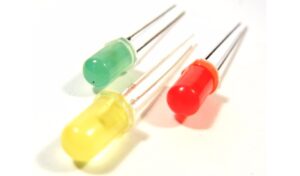LED’s are perhaps the most interesting electronic component that we use in circuit. LED’s are (Light Emitting Diode) components which can emit a specific light. It can be RED, Green, Blue or Yellow. LED’s require very less voltage to turn ON (typically 3v) and they have a very long life. We see LED’s in power indicators in almost any electronic appliance. The power light we see on TV, DVD, microwave, in TV remote control are all LED’s. We have LED TV’s now a day’s which uses LED’s to give the backlighting to the LCD Panel in it

LED’s are directional devices and are required to be connected in a specified direction only in a circuit. The LED’s are having two leads, they are called as Anode, and Cathode as shown in below image
The above image shows the LED circuit symbol in the upper side and how to identify the leads of LED in the lower side.
LED Usage
The most important thing to remember about using LED in any electronic circuits, is that never, I mean never ever connect LED to any Power Source directly. LED’s are to be always connected to any power source with a series resistor.

LED Series Resistor
There is a little Mathematics here about what should be the idle value of series resistor with LED. To be frank, there is no honest “value” or any real value. All the LED’s have a specified maximum current specified by the manufacturer which should not be exceeded, that’s it. We can use any resistor which limits the current flowing through resistor less than a specified value. As a thumb rule, all common LED’s have a rating of maximum of 60mA (mili amperes) It means, we should not allow more than 60 mA of current to pass through LED otherwise it will get damaged.
Using the simplest Ohms Law, we have this
R = V / I
Where
R = Resistance
V = Voltage Applied
I = current passing through the circuit
So if we want to limit current to a known value, we have to put the known voltage (which we apply, say 9v as our battery voltage) and the known Current in this equation to get resistor value.
For the sake, we’ll assume we are working on 9v, and we wish to limit our current to 20 mA
So
R = V / I
Hence,
R = 9v / 20mA
R = 9v / 0.02 Ampere
R = 450 ohm
As 450ohm is not a standard value, we can choose any value close to it, for example, we can use 470 Ohm or even 680 Ohm.
Remember, the LEDs in a most electronic circuits are used only for the purpose of Indication and not to light up a room. So we must use the resistor value as large as possible on which LED is lit, so as to keep our overall current consumption limited.


